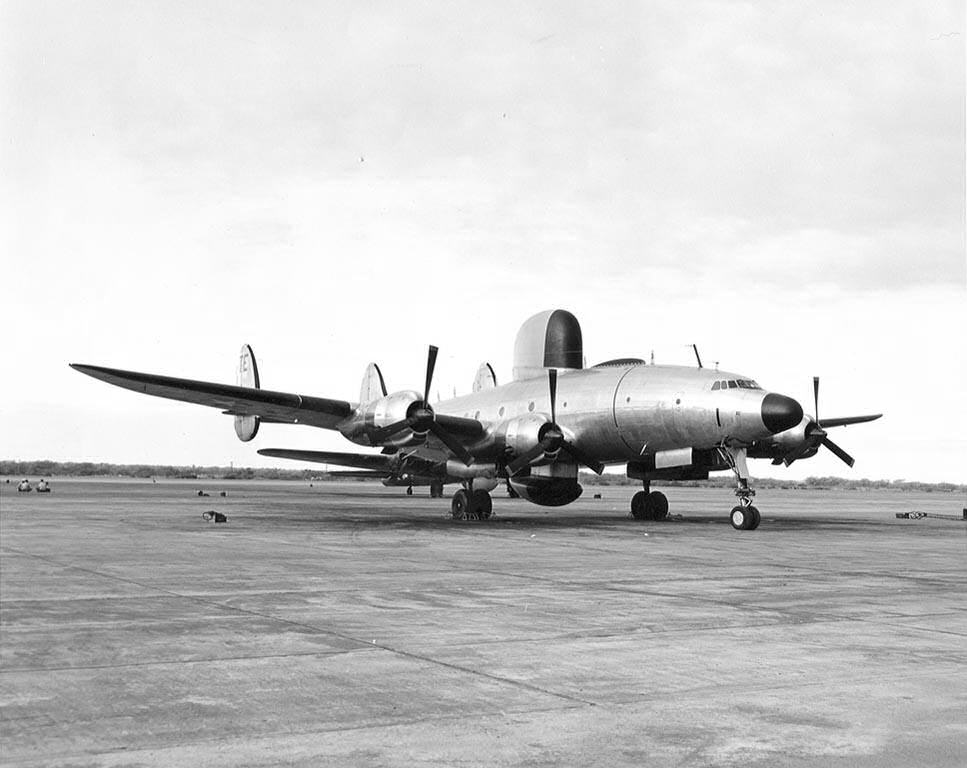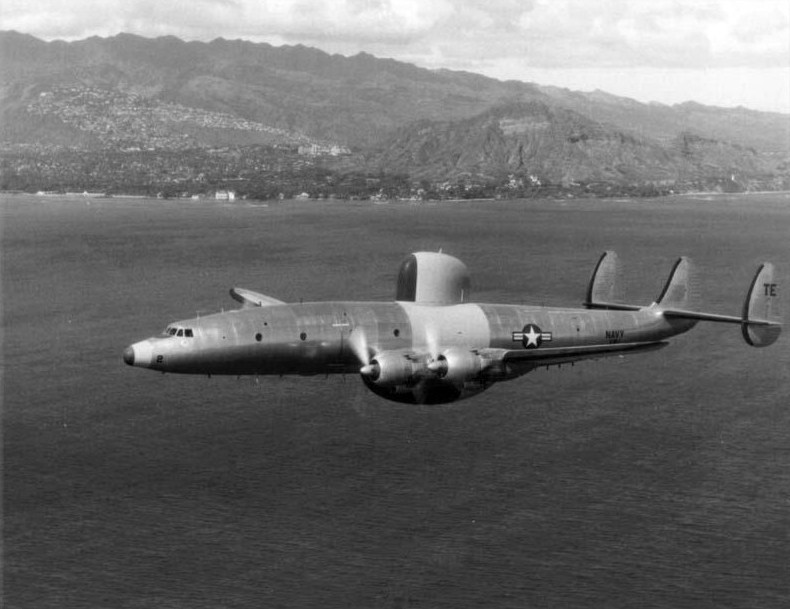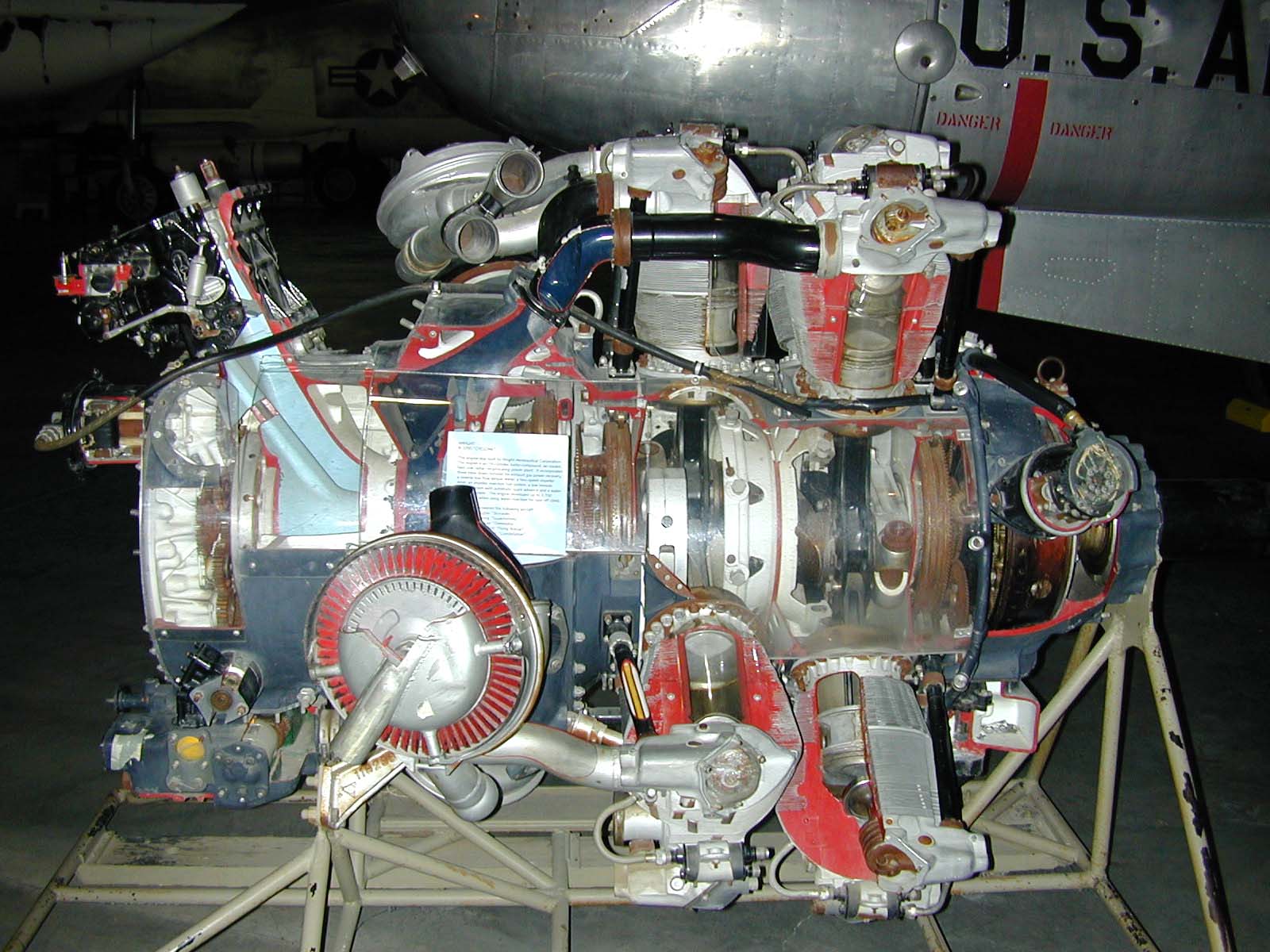|
R7V
The Lockheed C-121 Constellation is a military transport version of the Lockheed Constellation. A total of 332 aircraft were constructed for both the United States Air Force and United States Navy for various purposes. Numerous airborne early warning versions were also constructed. The C-121 later saw service with smaller civilian operators until 1993. Design and development Lockheed's first attempt at a military version of the Constellation airliner had been unsuccessful. This was largely due to the problems encountered by the Wright R-3350 engines that powered the aircraft. After the war, the few military Constellations built (designated C-69) were retrofitted by Lockheed for use in the post-war airline industry as the L-049. In 1947, Lockheed unveiled a more economical Constellation. The L-749 as it was known, had extra fuel capacity and a more economical version of the R-3350. However, Lockheed had lost 1200 workers that same year. By 1948, production of the L-749 was at ... [...More Info...] [...Related Items...] OR: [Wikipedia] [Google] [Baidu] |
Lockheed L-1249 Super Constellation
The Lockheed L-1249 Super Constellation was a turboprop-powered version of the Lockheed Constellation aircraft family. Built in 1954 and 1955, the aircraft were used as prototypes for possible future military transport aircraft for both the United States Air Force and United States Navy. Both aircraft saw very short lives and the airframes were later used to build L-1049 Super Constellations. Design and development On 18 August 1950, the United States Navy signed a contract for 11 military transport versions of the Lockheed L-1049. The aircraft were to have been convertible troop/cargo transports, based on the model L-1049B (which was already being constructed as the PO-2W Warning Star). The R7O-1 would have also featured round portholes in place of the rectangular ones on Air Force C-121C Constellations. The aircraft entered evaluation service in the Navy's oldest test squadron, VX-1, based in Patuxent River, Maryland. In November 1951, an idea came about to build a turbine-p ... [...More Info...] [...Related Items...] OR: [Wikipedia] [Google] [Baidu] |
Lockheed Constellation
The Lockheed Constellation ("Connie") is a propeller-driven, four-engined airliner built by Lockheed Corporation starting in 1943. The Constellation series was the first pressurized-cabin civil airliner series to go into widespread use. Its pressurized cabin enabled commercial passengers to fly well above most bad weather for the first time, thus significantly improving the general safety and ease of air travel. Several different models of the Constellation series were produced, although they all featured the distinctive triple-tail and dolphin-shaped fuselage. Most were powered by four 18-cylinder Wright R-3350 Duplex-Cyclones. In total, 856 were produced between 1943 and 1958 at Lockheed's plant in Burbank, California, and used as both a civil airliner and as a military and civilian cargo transport. Among their famous uses was during the Berlin and the Biafran airlifts. Three served as the presidential aircraft for Dwight D. Eisenhower, one of which is featured at the National M ... [...More Info...] [...Related Items...] OR: [Wikipedia] [Google] [Baidu] |
L-1049 Super Constellation
The Lockheed L-1049 Super Constellation is an American aircraft, a member of the Lockheed Constellation aircraft line. The L-1049 was Lockheed's response to the successful Douglas DC-6 airliner, first flying in 1950. The aircraft was also produced for both the United States Navy as the WV / R7V and U.S. Air Force as the C-121 for transport, electronics, and airborne early warning and control aircraft. Development Beginning in 1943, Lockheed planned stretched variants of the Constellation family. The first was the L-049 with a fuselage lengthened by 13 feet (4 meters) and the second the L-749 stretched 18 feet (5.5 meters). Douglas launched a stretched version of its DC-6 airliner as a cargo transport, designated DC-6A, for both military and civilian operators. Douglas was soon to launch a passenger version (the DC-6B) of this new aircraft. The DC-6B could carry 23 more passengers than Lockheed's current production L-749 Constellation. In 1950, Lockheed had repurchased the X ... [...More Info...] [...Related Items...] OR: [Wikipedia] [Google] [Baidu] |
Military Air Transport Service
The Military Air Transport Service (MATS) is an inactive Department of Defense Unified Command. Activated on 1 June 1948, MATS was a consolidation of the United States Navy's Naval Air Transport Service (NATS) and the United States Air Force's Air Transport Command (ATC) into a single joint command. It was inactivated and discontinued on 8 January 1966, superseded by the Air Force's Military Airlift Command (MAC) as a separate strategic airlift command, and it returned shore-based Navy cargo aircraft to Navy control as operational support airlift (OSA) aircraft. In 1966, the World War II Air Transport Command (ATC) (1942–1948) and the Military Air Transport Service were consolidated with Military Airlift Command (MAC) (1966–1992). Overview The Military Air Transport Service (MATS) was activated under United States Air Force Major General Laurence S. Kuter, in order to harness interservice efforts more efficiently. It was an amalgamation of Navy and Army air transport comma ... [...More Info...] [...Related Items...] OR: [Wikipedia] [Google] [Baidu] |
EC-121 Warning Star
The Lockheed EC-121 Warning Star was an American airborne early warning and control radar surveillance aircraft operational in the 1950s in both the United States Navy (USN) and United States Air Force (USAF). The military version of the Lockheed L-1049 Super Constellation was used to serve as an airborne early warning system to supplement the Distant Early Warning Line, using two large radomes (a vertical dome above and a horizontal one below the fuselage). It replaced the TBM-3W used by the USN. Some EC-121s were also used for signal intelligence gathering. The EC-121 was introduced in 1954 and phased out in 1978, although a single specially modified EW aircraft remained in USN service until 1982. The USN versions when initially procured were designated WV-1 (PO-1W), WV-2, and WV-3. The USAF Warning Stars served during the Vietnam War both as electronic sensor monitors and as a forerunner to the Boeing E-3 Sentry AWACS. USAF aircrews adopted its civil nickname, "Connie" (d ... [...More Info...] [...Related Items...] OR: [Wikipedia] [Google] [Baidu] |
Lockheed EC-121 Warning Star
The Lockheed EC-121 Warning Star was an American airborne early warning and control radar surveillance aircraft operational in the 1950s in both the United States Navy (USN) and United States Air Force (USAF). The military version of the Lockheed L-1049 Super Constellation was used to serve as an airborne early warning system to supplement the Distant Early Warning Line, using two large radomes (a vertical dome above and a horizontal one below the fuselage). It replaced the TBM-3W used by the USN. Some EC-121s were also used for signal intelligence gathering. The EC-121 was introduced in 1954 and phased out in 1978, although a single specially modified EW aircraft remained in USN service until 1982. The USN versions when initially procured were designated WV-1 (PO-1W), WV-2, and WV-3. The USAF Warning Stars served during the Vietnam War both as electronic sensor monitors and as a forerunner to the Boeing E-3 Sentry AWACS. USAF aircrews adopted its civil nickname, "Connie" ( ... [...More Info...] [...Related Items...] OR: [Wikipedia] [Google] [Baidu] |
Lockheed C-69 Constellation
The Lockheed C-69 Constellation was a four-engined, propeller-driven military transport aircraft developed during World War Two. It was co-developed with the Lockheed Constellation airliner. It first flew in 1943, and production of the 22 constructed was shared between the United States Army Air Forces (15) and commercial carriers. Most of the C-69 aircraft built were later converted into civilian airliners under the designation Lockheed L-049 Constellation.Breffort, Dominique. Lockheed Constellation: from Excalibur to Starliner Civilian and Military Variants. Paris: Histoire and Collecions, 2006. Print. . p. 11 to p. 17. Design and development Following the Attack on Pearl Harbor and the United States entering World War II, the assembly lines at the Lockheed Aircraft Corporation were taken over by the American government for the war effort. Along with the assembly lines, the Lockheed L-049 Constellation airliner was also requisitioned and redesignated C-69 and was to be used as ... [...More Info...] [...Related Items...] OR: [Wikipedia] [Google] [Baidu] |
L-049
The Lockheed L-049 Constellation was the first model of the Lockheed Constellation aircraft line. It entered service as the C-69 military transport aircraft during World War II for the United States Army Air Forces and was the first civilian version after the war. When production ended in 1946 it was replaced by the improved L-649 and L-749 Constellation. History Design and development In June 1939, Howard Hughes, the owner of Transcontinental & Western Air (later called Trans World Airlines and abbreviated TWA for short), prepared a meeting at his Hancock Park residence in California. Jack Frye (then president of TWA) attended along with three executives from the Lockheed Aircraft Corporation which included designer Clarence "Kelly" Johnson. During the meeting Hughes expressed his concerns for what he called the "airliner of the future". Lockheed's airliner under development at the time, the L-044 Excalibur, did not meet the requirements. When the meeting ended with Hughe ... [...More Info...] [...Related Items...] OR: [Wikipedia] [Google] [Baidu] |
L-749 Constellation
The Lockheed L-749 Constellation is the first Lockheed Constellation to regularly cross the Atlantic Ocean non-stop. Although similar in appearance to the L-649 before it, the L-749 had a larger fuel capacity, strengthened landing gear, and eventually weather radar. Design and development In early 1947, the Lockheed Aircraft Corporation unveiled the L-749, a derivative of its L-649 Constellation with fuel tanks to increase its maximum range by . Due to the increased weight, the landing gear and tires had to be strengthened. Jet stacks were also introduced, increasing speed by . These jet stacks increased the noise, requiring more insulation. As with the L-649, ten different layouts of the internal cabin were possible. Airlines originally attracted to the L-649 changed their orders to the L-749. The L-749 was to become the standard version of the regular Constellation.Breffort, ''Lockheed Constellation'', pp. 40-45. [...More Info...] [...Related Items...] OR: [Wikipedia] [Google] [Baidu] |
L-749
The Lockheed L-749 Constellation is the first Lockheed Constellation to regularly cross the Atlantic Ocean non-stop. Although similar in appearance to the L-649 before it, the L-749 had a larger fuel capacity, strengthened landing gear, and eventually weather radar. Design and development In early 1947, the Lockheed Aircraft Corporation unveiled the L-749, a derivative of its L-649 Constellation with fuel tanks to increase its maximum range by . Due to the increased weight, the landing gear and tires had to be strengthened. Jet stacks were also introduced, increasing speed by . These jet stacks increased the noise, requiring more insulation. As with the L-649, ten different layouts of the internal cabin were possible. Airlines originally attracted to the L-649 changed their orders to the L-749. The L-749 was to become the standard version of the regular Constellation.Breffort, ''Lockheed Constellation'', pp. 40-45. [...More Info...] [...Related Items...] OR: [Wikipedia] [Google] [Baidu] |
Wright R-3350
The Wright R-3350 Duplex-Cyclone is an American twin-row, supercharged, air-cooled, radial aircraft engine with 18 cylinders displacing nearly . Power ranged from 2,200 to over 3,700 hp (1,640 to 2,760 kW), depending on the model. Developed before World War II, the R-3350's design required a long time to mature before finally being used to power the Boeing B-29 Superfortress. After the war, the engine had matured sufficiently to become a major civilian airliner design, notably in its turbo-compound forms, and was used in the Lockheed L-1049 Super Constellation airliners into the 1990s. The engine is commonly used on Hawker Sea Fury and Grumman F8F Bearcat Unlimited Class Racers at the Reno Air Races. Its main rival was the , Pratt & Whitney R-4360 Wasp Major, first run some seven years after the Duplex-Cyclone's beginnings. Design and development In 1927, Wright Aeronautical introduced its famous "Cyclone" engine, which powered a number of designs in the 193 ... [...More Info...] [...Related Items...] OR: [Wikipedia] [Google] [Baidu] |
Air National Guard
The Air National Guard (ANG), also known as the Air Guard, is a federal military reserve force of the United States Air Force, as well as the air militia of each U.S. state, the District of Columbia, the Commonwealth of Puerto Rico, and the territories of Guam and the U.S. Virgin Islands. It, along with each state's, district's, commonwealth's or territory's Army National Guard component, makes up the National Guard of each state and the districts, commonwealths and territories as applicable. When Air National Guard units are used under the jurisdiction of the state governor they are fulfilling their militia role. However, if federalized by order of the President of the United States, Air National Guard units become an active part of the United States Air Force. They are jointly administered by the states and the National Guard Bureau, a joint bureau of the Army and Air Force that oversees the United States National Guard. Air National Guard operating forces are structured wh ... [...More Info...] [...Related Items...] OR: [Wikipedia] [Google] [Baidu] |








